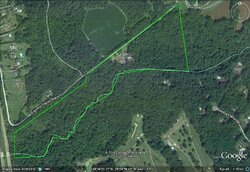DaveH9 said:
if one can grow as much wood as one uses in a year, then the heat is carbon neutral. Insulation and stove efficiency can help make this happen. By using solar to supplement the wood heat, or wood to supplement solar heat. These new passive solar haus would be easy to heat with less than acre of wood lot, one 8 inch tree a year would do it. If you grew fast growing hybrid popular it would be interesting to see how much land would be needed compared to btus.
Well said.
And, an interesting question -- Just as a rough guess on the question:
The ref listed below says 5 tons of poplar per acre in the Ukraine (I'm sure we can do better

Taking a 2000 sqft house in a 6000 heating degree day climate (cold), and with R60 ceilings and floors, R30 walls, R4 windows, and 0.3 ACH infiltration, the yearly heat demand is about 39 million BTU, and of this about 17 million is met by internal heat gains (lights, bodies, dogs, ...) leaving 22 million BTU to be met with heating fuel. It could be less than this if some passive solar was used in the house design, but say no solar. Not sure that this home would meet Passive House Institute standards, but its a good efficient home.
http://www.builditsolar.com/References/Calculators/HeatLoss/HeatLoss.htm
Could not find a value for heating value of poplar, but aspen is listed as 27 lbs/cf, 2290 lbs per cord, 14.7 million BTU/cord.
So, with an 80% efficient wood burner, it would take (22/14.7)/0.8 = 1.87 cords, or (1.87)(2290) = 4280 lbs of poplar(aspen) to heat the house.
With the 5 tons of poplar per acre, this would be less than half an acre -- as a very rough estimate.
Seems like a good strategy for a pretty close to zero net carbon home.
Gary
From:
http://www.hemphasis.net/Paper/paper_files/hempvtree.htm
"In Ukraine, poplar wood grown for pulp produces 5.1 tons/acre/yr, and dry stems of hemp produce 3.24-4.05 tons/acre/yr. This is 4-5 times more than indigenous forests in Ukraine, and approaches the increment of the most productive plantations of fast growing poplars. The Ukrainian Institute of Bast Crops expects hemp to yield an average of 5 ton/acre of dry stems. The cost of transporting hemp pulp, dispersed over larger territories than wood, removal of the ash content, and the lower pulp yield compared to wood pulp make non-wood pulp more expensive. However, the Ukrainian Institute compared the labor costs of growing and harvesting hemp and poplars in 1992 and found the costs were comparable. "
Heating value for woods:
http://www.builditsolar.com/References/woodhvrs.htm




